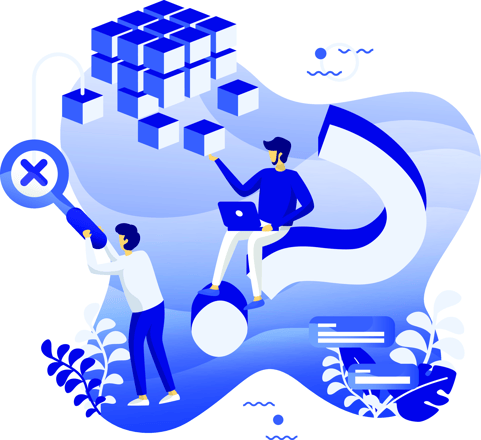What can I use Canvas iPaaS for

The power of iPaaS
The strength of an iPaaS lies in its ability to seamlessly integrate different applications, automate tasks, and drive efficiency across business processes, all while ensuring data security and compliance.
In the digital ecosystem of business, the ability to connect different business systems and applications is not just a convenience—it's a strategic necessity. Integration Platform as a Service (iPaaS) solutions, like ConnectMyApps' Canvas, are revolutionizing how businesses approach and manage their digital infrastructure. This article delves into the practical areas of use for Canvas, providing concrete examples of integrations and applications that showcase its versatility and power.
Optimizing Human Resources: The People Perspective
Human resources (HR) management can greatly benefit from Canvas by integrating HR platforms with other business systems. For instance, integrating an HR system like BambooHR with a time tracking tool and payroll software can automate the entire payroll process, reducing errors and freeing up HR professionals to focus on strategic initiatives.
Example Integrations:
-
HR to Payroll: Streamlining employee onboarding, time tracking, and payroll processing.
-
Recruitment to Onboarding: Automating the transition of candidate information from recruitment platforms to onboarding systems.
-
Learning Management to HR: Tracking employee training progress and certifications.
Enhancing Customer Experience: A Unified Approach
Customer experience is paramount, and Canvas helps businesses deliver a seamless journey from the first touchpoint to post-sales support. For example, a B2B software company might use Canvas to connect their customer support software, such as Zendesk, with their CRM platform. This ensures that sales representatives have access to a customer's support history, enabling personalized and informed interactions that can boost customer satisfaction and retention.
Example Integrations:
-
CRM to Support Desk: Providing a 360-degree view of customer interactions.
-
E-commerce to Shipping: Automating order fulfillment and tracking information updates.
-
Order confirmations can trigger events to e.g Customer Service portal for faster and better customer service
-
Marketing Automation to CRM: Capturing leads and interactions from web and social platforms directly into the sales pipeline.
Financial Clarity: Real-Time Insights for Better Decisions
Financial management is another area where Canvas shines. By connecting accounting software with other operational tools, businesses can gain better insights into their financial health. For example, integrating QuickBooks with project management tools like Asana or Trello can provide immediate visibility into project costs and profitability.
Example Integrations:
-
Accounting to Business Intelligence: Gaining insights to make better decisions.
-
Expense Management to Accounting: Automating expense approvals and reimbursements.
-
Ensuring accurate balance sheet reconciliation and payment tracking.
Supply Chain Synchronization: The Logistics Lifeline
Supply chain management is complex, but Canvas simplifies it by integrating logistics, inventory, and order management systems. A manufacturing company, for instance, could integrate their supply chain management software with their vendors' systems to automate ordering processes, manage inventory levels, and track shipments in real-time.
Example Integrations:
-
Inventory Management to E-commerce: Synchronizing stock levels with online sales channels.
-
Supplier Systems to ERP: Automating purchase orders and supply chain logistics.
-
Warehouse Management to Retail Systems: Ensuring inventory accuracy across multiple retail locations.
Marketing Magic: Crafting Cohesive Campaigns
Marketing efforts can be amplified with Canvas by integrating marketing automation tools such as Hubspot with CRM systems and analytics platforms. A marketing department could connect Salesforce with their marketing automation software to tailor campaigns based on user behavior and customer insights.
Example Integrations:
-
Marketing Automation to Analytics: Personalizing marketing campaigns based on user data.
-
Social media to CRM: Tracking campaign performance and lead generation from social channels.
-
Email Marketing to E-commerce: Triggering cart abandonment emails and promotional offers.
IT Infrastructure: A Seamless Tech Ecosystem
For IT departments, Canvas is a game-changer, enabling the integration of various IT management tools for a cohesive ecosystem. For example, integrating a ticketing system like JIRA with monitoring tools such as New Relic can automate alerting and issue resolution processes, enhancing IT responsiveness and uptime.
Example Integrations:
-
Monitoring Tools to Ticketing Systems: Streamlining incident management workflows.
-
Version Control to Continuous Integration: Automating code deployments and testing.
-
Cloud Storage to Collaboration Tools: Facilitating file sharing and team collaboration.
Conclusion: The Transformative Applications of Canvas
Canvas by ConnectMyApps is not just an iPaaS; it's a catalyst for transformation across various business functions. From operations to customer service, HR to finance, supply chain to marketing, and IT infrastructure, Canvas provides the integrative muscle that modern businesses need to operate efficiently, innovate rapidly, and scale seamlessly. Through practical, real-world examples, we see how Canvas is not just solving problems but also unlocking new opportunities for businesses to excel in their respective industries.










